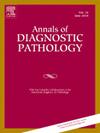PSMA免疫组织化学在结直肠肿块活检中的诊断价值
IF 1.4
4区 医学
Q3 PATHOLOGY
引用次数: 0
摘要
在一个大的结直肠肿块形成病变的小活检中,诊断浸润是具有挑战性的。然而,这种诊断对直肠癌患者的治疗具有重要意义。前列腺特异性膜抗原(PSMA)与肿瘤新生血管生成有关。我们比较了PSMA在侵袭性结直肠癌(CRC)和切除腺瘤活检中的表达。65例浸润性结直肠癌活检,48例手术切除的大腺瘤和5例取样错误的结直肠癌活检(前体腺瘤取样无浸润)。行PSMA和CD34免疫组化,比较结直肠癌活检组织和腺瘤组织中肿瘤内PSMA+血管与CD34+血管的比值。在结直肠癌队列中,临床病理特征包括结缔组织增生、良性/非发育不良组织的数量和肿瘤分级与内皮PSMA表达的相关性进行了评估。PSMA/CD34比值在腺瘤(2.8%)和抽样误差较大的结直肠癌活检(2.5%)中显著低于结直肠癌活检(19.1%)。使用5%的临界值,CRC准确诊断的敏感性、特异性、阳性和阴性预测值分别为78.5%、83.3%、86.4%和74.1%。较低的PSMA/CD34比值与活检中较高的良性组织百分比相关,但PSMA/CD34比值与其他临床病理参数之间未发现其他关联。无论结缔组织增生是否存在,PSMA在结直肠癌活检中的表达明显高于前体病变和腺瘤。我们的观察表明,PSMA可以作为一种辅助工具,在具有不明显的结缔组织增生的挑战性活检中确认侵袭。本文章由计算机程序翻译,如有差异,请以英文原文为准。
Diagnostic utility of PSMA immunohistochemistry in colorectal mass biopsy
Rendering a diagnosis of invasion can be challenging in a small biopsy of a large colorectal mass-forming lesion. However, this diagnosis can have major implications in the management of patients with rectal cancer. Prostate-specific membrane antigen (PSMA) is associated with tumor neoangiogenesis. We compared PSMA expression in biopsies of invasive colorectal cancer (CRC) and in resected adenomas. 65 biopsies from invasive CRC, 48 surgically resected large adenomas and 5 CRC biopsies with sampling error (precursor adenoma was sampled without invasion) were retrieved. PSMA and CD34 immunohistochemistry were performed and the ratio of PSMA+ neovasculature to CD34+ vasculature within the tumors was compared between CRC biopsies and adenomas. In the CRC cohort, clinicopathological characteristics including desmoplasia, the amount of benign/nondysplastic tissue and tumor grade were evaluated for correlation with endothelial PSMA expression. PSMA/CD34 ratio was significantly lower in adenomas (2.8 %) and in CRC biopsies with sampling error (2.5 %) than in CRC biopsies (19.1 %). Using a 5 % cut-off, the sensitivity, specificity, positive, and negative predictive values for accurate diagnosis of CRC were 78.5 %, 83.3 %, 86.4 % and 74.1 %, respectively. A lower PSMA/CD34 ratio was associated with a higher percentage of benign tissue in the biopsy, but no other association was found between PSMA/CD34 ratio and other clinicopathologic parameters. PSMA expression is significantly higher in CRC biopsies than in precursor lesions and adenomas irrespective of the presence of desmoplasia. Our observation indicates that PSMA can serve as an adjunctive tool to confirm invasion in challenging biopsies with inconspicuous desmoplasia.
求助全文
通过发布文献求助,成功后即可免费获取论文全文。
去求助
来源期刊
CiteScore
3.90
自引率
5.00%
发文量
149
审稿时长
26 days
期刊介绍:
A peer-reviewed journal devoted to the publication of articles dealing with traditional morphologic studies using standard diagnostic techniques and stressing clinicopathological correlations and scientific observation of relevance to the daily practice of pathology. Special features include pathologic-radiologic correlations and pathologic-cytologic correlations.

 求助内容:
求助内容: 应助结果提醒方式:
应助结果提醒方式:


